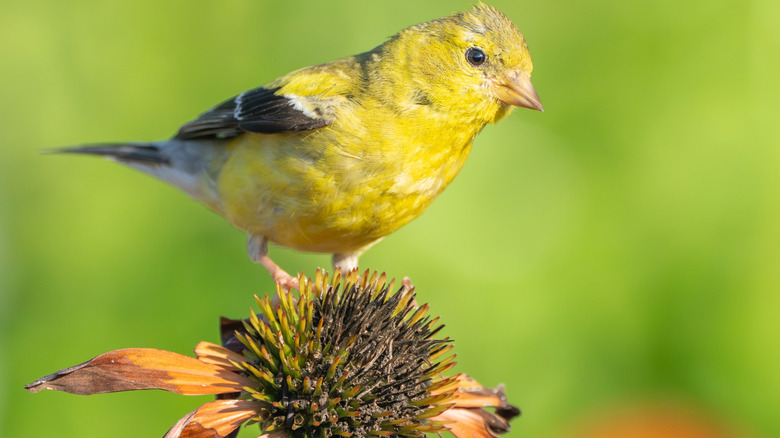Don't Make This Mistake During Fall Cleanup
Cooling weather will let you know it's time for fall cleanup and preparing your garden for the winter to come. Many gardeners, however, tend to make a very common mistake: They cut back perennial flowers to the ground. Aggressive deadheading after flowers go dormant could mean less reseeding next season. It also adversely affects birds and other pollinators in your garden.
The idea of leaving wilted or dried flowers on stems in your garden might seem counterintuitive, but most perennials really don't need pruning or deadheading in autumn. In fact, slicing them down to the soil means you don't allow flower heads to dry out and go to seed. This can cause more problems than you might realize. Doing so means inhibiting propagation for flowers that reseed themselves, such as the daisy-like aster. Getting rid of seed heads also removes needed food for birds like goldfinches and cardinals, who rely on them in the winter.
No one wants to take away a colorful songbird's favorite winter meal. Plus, getting rid of hollow, dried-out flowers means you might also be accidentally removing habitats for solitary bees and wasps. These sorts of bees rarely sting people, but they are important pollinators. They live alone inside the empty stalks of dead flowers or holes in tree bark or branches. Nature works in mysterious ways, but it doesn't always require our intervention. It's also why wild landscaping might be the future of gardening.
Cutting back dead perennial flowers means fewer seeds
If you do cut back all dormant perennials, you're taking away the chance that these prolific flowers will reseed and offer even more blooms next spring. Perennials like coneflowers (Echinacea purpurea) can benefit from being left alone. Whatever seeds the birds don't eat will fall to the ground and may become new coneflowers next year, helping to propagate themselves without you lifting a finger.
Leaving flowers offers another benefit to perennials, too. Even though flowers look dead and useless to us, they can still benefit the roots of the plant beneath, giving them an added layer of insulation during cold weather and even an ongoing nutrient boost. The dead leaves or petals that fall on the ground can freeze in the winter, providing a temporary blanket of warmth. Some perennials, like anise hyssop (Agastache spp.), really depend on the insulating layer during cold snaps.
If you trim these varieties back too much in the fall, you risk exposing the plant's crowns to frigid temperatures that could kill them. Plus, the dead leaves and stems will thaw and promptly decompose in the spring, giving your perennials an instant shot of nature's fertilizer. The debris will also give cover to insects trying to survive the winter. The same can be said during autumn, which is one reason why you shouldn't rake all the fallen leaves in your yard.
Leave most perennials alone this fall, but with these exceptions
Maybe it's time to embrace the natural beauty dormant perennials provide. They do add a bit of texture and visual interest to the garden over the winter. If you really want to get the most out of fall cleanup, focus on pulling up weeds one last time before the onset of winter. You'll be glad you did when fewer weeds have reseeded themselves come spring.
Of course, there could be perennials you should prune in the fall. Always trim away any diseased flowers or foliage with leaf spot. If you've noticed signs of a fungal infection with flowers, remove them before the infection spreads to other plants. Winter weather alone won't kill most fungus. Some perennials that are especially susceptible to disease, such as bee balm (Monarda spp.), can be cut back to avoid outbreaks of powdery mildew.
You might want to trim away the dead leaves of hostas, too, especially if you've had a slug problem in your garden. It's also a good idea to prune bearded irises (Iris x germanica), because iris borers lay eggs on them that lie dormant through the winter. These pests hatch in the spring and feed on the flower's rhizomes. If left untreated, iris borers might kill these showy flowers. When trimming any perennial flower, leave several inches of stems as a marker, so that you don't accidentally plant something else on top of them.


